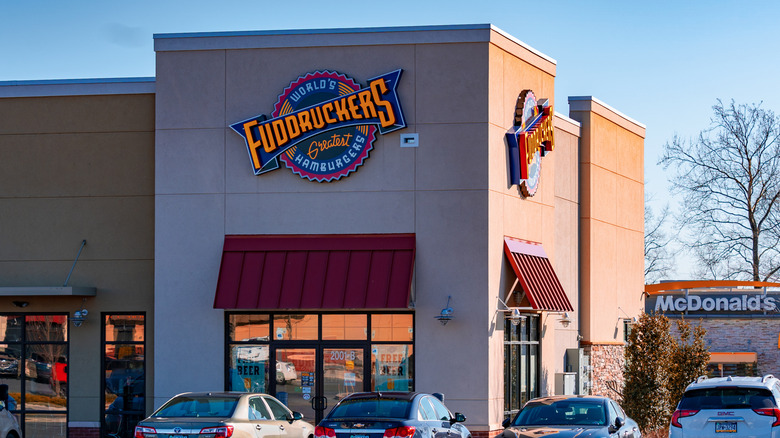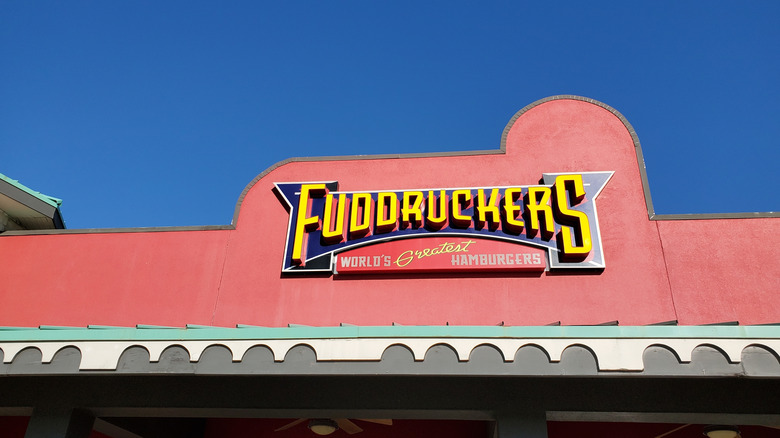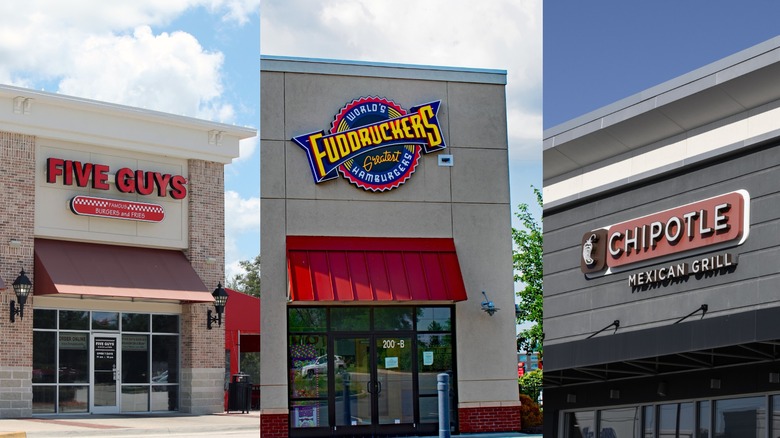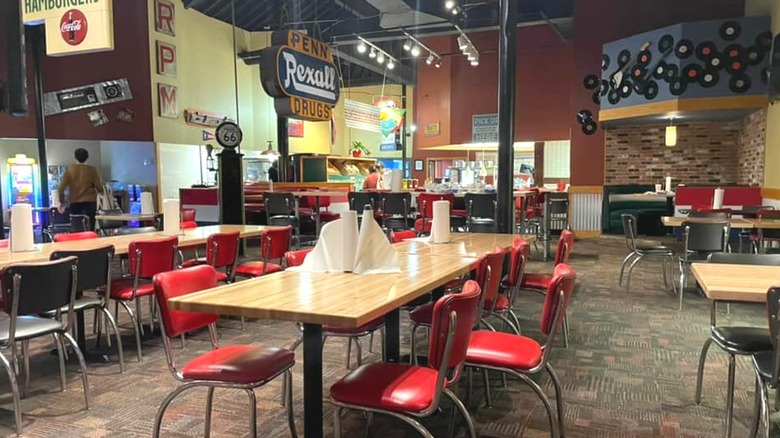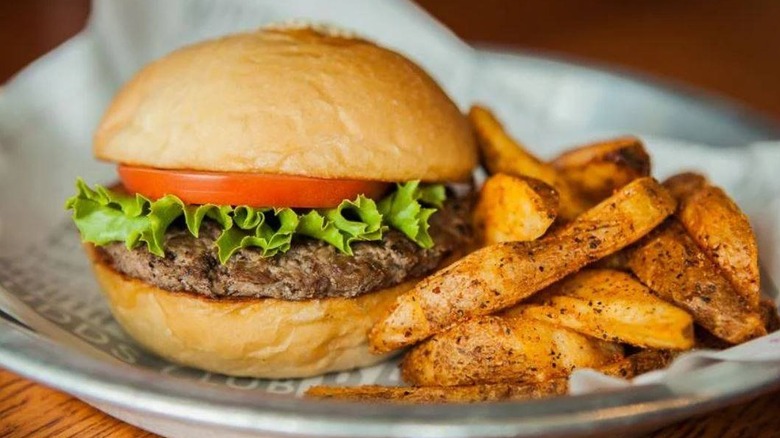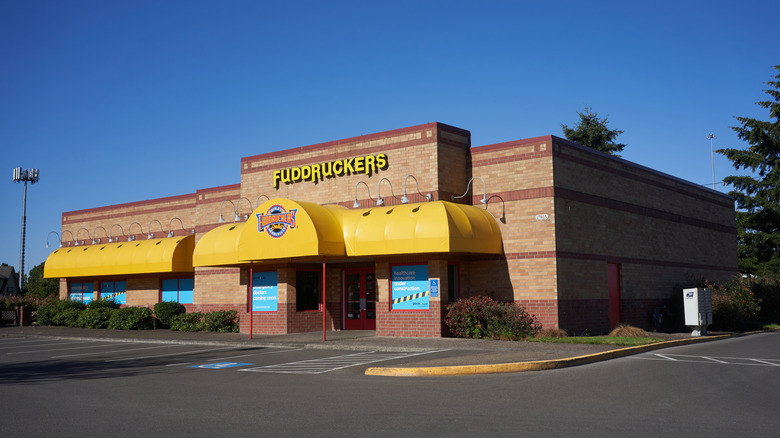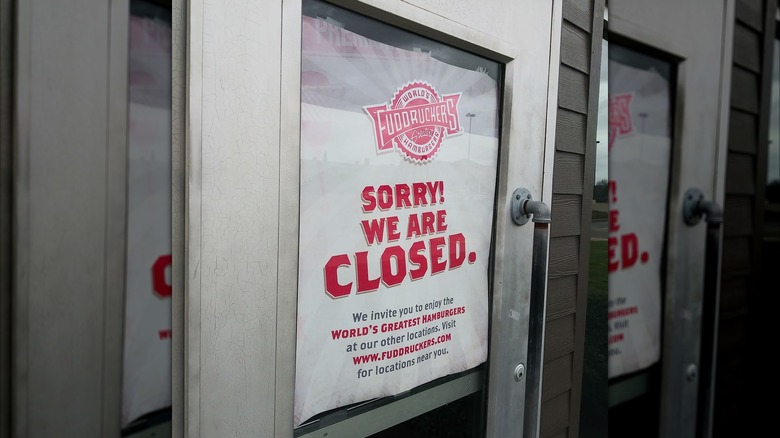9 Reasons Fuddruckers Is Struggling
American burger chain Fuddruckers was founded in 1980 in San Antonio, Texas. Once called "Freddie Fuddruckers," it's one of a few popular restaurants that initially had a different name — but after just a year, it would drop the extra name to become the brand we all know today. Still, the restaurant quickly attracted crowds with a bold claim: serving the "World's Greatest Hamburgers." Customers loved the unique build-your-own-burger concept, and its fresh, high-quality ingredients made the fast casual atmosphere feel elevated.
At first, it seemed like Fuddruckers was an instant classic with American diners. Its growth was explosive, expanding to 150 locations within a few years of its conception. Several smart marketing moves including special family discounts and entertainments made it a go-to dinner spot for parents and children. In the years following, though, financial troubles, ownership changes, and shifting consumer preferences would gradually erode the restaurant's image and popularity.
Today, Fuddruckers has faded into near obscurity, just like the many other beloved chain restaurants that are disappearing. Just 52 locations remain, and fans frequently wonder online where their former favorite burger joint has gone. Let's explore nine key reasons this once-popular restaurant is struggling.
1. Rapid expansion in the 1980's put Fuddruckers' finances on the ropes
Fuddruckers' initial success in Texas led the company to pursue an aggressive expansion strategy. First, it went public with an IPO in 1983. Over the next two years, the restaurant chain would open a whopping 95 new restaurants, for a total of 100 nationwide locations by 1985.
However, the rapid growth plan came with high costs. The company was operating at a loss, according to then-president William Baumhauer, who assumed leadership in 1985 upon the retirement of founder Phil Romano. To keep the company afloat, he was forced to close 20 of the new restaurants by 1987.
"We were fortunate to survive," Baumhauer remarked of the difficult time in the chain's history to Nation's Restaurant News. Though Fuddruckers managed to recover and become profitable again, these early closures were a red flag for the restaurant brand's long-term stability and financial success.
2. Explosive growth in the fast casual restaurant industry created more competition
In the early 2000s, the fast casual dining sector was abuzz with new concepts like Chipotle, Five Guys, and Panera Bread. Fast casual was different from fast food, because it offered customers meals that were fresher and higher quality, while still maintaining a casual quick-serve atmosphere. Fuddruckers' build-your-own concept, which had once been unique, was now available for all types of cuisines.
Not only that, but customers were beginning to lean towards more health-conscious food options with a focus on local and organic ingredients. Trending brands in the 2000s were sleeker and cleaner, but Fuddruckers' branding remained in its original bright and bold classic American diner style all the way until 2019. This inability to adapt to changing consumer demands became apparent in the revenue reports. Fuddruckers' revenue peaked in 2004, followed by a period of decline that would last for several years.
3. The Great Recession hit sit-down restaurants hard
Although the Great Recession may have brought us the boneless wing, it had an overall devastating impact on the restaurant industry. The blow was particularly heavy for sit-down and fast casual establishments leading to many chain restaurants declining and disappearing during this period.
In the years following the 2008 financial crisis, consumers were being more conscious of their budgets. That meant spending less on eating out, instead opting for cheaper fast food options or cooking meals at home.
In the years leading up to the 2008 recession, Fuddruckers' finances were already on the ropes, with revenue declining significantly in 2006 and 2007. This made the nationwide financial crisis an even more devastating blow. In 2010, Fuddruckers' then-parent company, Magic Brands, would file for bankruptcy due to high debts and low cashflow. The recession accelerated the decline of the Fuddruckers brand, and its fate was once again unsure.
4. Fuddruckers has had frequent changes in ownership, increasing instability and inconsistency
Fuddruckers has changed hands many times over the years. First, the restaurant's founder Phil Romano left the company in 1988 to start Macaroni Grill — one of America's most popular Italian chains to this day.
Over the next ten years, the brand was sold multiple times, with each transition bringing drastic strategy and operational changes that wouldn't be seen through to their conclusion. After Magic Brands' bankruptcy in 2010, fellow San Antonio-born restaurant brand Luby's acquired Fuddruckers. This partnership seemed to make sense as the brands had similar roots. However, Luby's would also struggle with expansion over the years, eventually selling Fuddruckers to a new owner in 2021.
Frequent ownership changes can be harmful for restaurants because they often lead to inconsistent customer experience, constantly shifting priorities, and a lack of long-term vision. Those factors can alienate loyal customers and confuse new visitors, ultimately damaging goodwill with the public. When it comes to Fuddruckers, these ownership shifts certainly didn't help their already struggling brand.
5. Luby's failed attempt at co-branded restaurants eroded the Fuddruckers image even further
After Luby's acquired Fuddruckers in 2010, it attempted to revitalize the brand by launching co-branded restaurants that combined both concepts under one roof. However, this new venture failed to resonate with customers for several reasons.
First, the Luby's customer base and the Fuddruckers customer base were quite different. Luby's typically found success catering to older clientele, as is typical of cafeteria-style restaurants. Meanwhile, Fuddruckers' most loyal customers were families with children. Although Luby's leadership hoped to create crossover between these two audiences, it never seemed to pan out.
Cafeteria-style restaurants were also heavily declining in popularity during this time, pushed out by fast food and fast casual dining. For Fuddruckers, a concept that was already struggling to compete, being associated with this out-of-style type of establishment was doing it no favors.
Luby's also made other changes, like adding Fuddruckers locations with sit-down table service or drive-throughs, and ending the ever-popular 'kids eat free' promotion. Instead of strengthening the brand, this sporadic attempt at new strategy only further muddled Fuddruckers' image in the public and alienated its core customer base.
6. The Fuddruckers burger quality has declined over the years
Fuddruckers prides itself on offering the "World's Greatest Hamburger," with fresh beef ground in-house and cooked to order. Each burger is even set atop a bun that was baked fresh in the restaurant. However, those promises may not ring so true for customers today.
In its early days, customers could watch their meat being prepared and cooked in an open concept kitchen, reinforcing Fuddruckers' commitment to quality and transparency. However, in the 1990s, the company began to move away from this model, renovating restaurants to have a more traditional hidden kitchen. This move reduced transparency and raised doubts about the freshness of its food.
Over time, customers began to notice a decline in quality, with many expressing disappointment in the taste and presentation of the burgers. This erosion of quality has been a major factor in the brand's decline, as customers can no longer get the great burgers they once loved from their favorite restaurant.
7. Staffing and operational issues have plagued the restaurant
Like many restaurants, Fuddruckers faced significant staffing and supply chain challenges during and after the COVID-19 pandemic. Rising labor costs and difficulties in hiring led to inconsistent service and operational inefficiencies that were noticed by customers. Restaurants would close at unexpected hours due to being understaffed, or would be out of certain crucial items, or would be unable to accept credit cards. Worst of all, there was no transparency with customers about these issues, leading to frustration and poor online reviews.
Some Fuddruckers locations were forced to close permanently due to these concerns. Meanwhile, the company tried to pivot by investing in smaller formats like ghost kitchens and mall food court stalls. These changes marked a departure from the original Fuddruckers experience and further weakened the brand's identity. Because experience was so integral to the original Fuddruckers brand and its success, this shift was seen by consumers as a desperate attempt to stay afloat rather than a strategic evolution.
8. The Fuddruckers concept is no longer favored among consumers
In a market saturated with fast casual burger joints, Fuddruckers struggles to gain favor with consumers. The elements that once made it popular, such as its music-themed decor and kid-friendly entertainment, are seen as outdated to today's customers.
Over the years, Fuddruckers has made changes to its concept, but they didn't align with changing trends — they came across as an effort to cut costs, and only served to make the brand less distinctive to customer. In areas that today's customers find most important, like sustainability and healthy eating, Fuddruckers failed to keep up.
Many restaurant chains are increasing prices to keep up with inflation, and Fuddruckers is no exception. However, customers no longer see the concept as valuable enough or worth the price. High-ticket items like elk and buffalo burgers may be a unique experience, but they cost far more than what today's consumers are willing to pay at a casual restaurant.
9. Restaurant closures and rumors of the end of Fuddruckers have left consumers confused
At its peak, Fuddruckers operated over 500 locations. Today, that number has dwindled to just over 50 worldwide. This dramatic reduction in locations, combined with several drawn-out closures and grand reopenings, has led to widespread confusion among consumers about where the chain stands. Many loyal fans of the chain would love to eat there again, but there may no longer even be a Fuddruckers in their state. In recent years, many have echoed this sentiment in online forums and social media comments, evidencing the widespread confusion. Many are wondering: What is happening with Fuddruckers?
This situation was compounded in 2024, when false rumors circulated on social media that the chain was shutting down entirely and closing all locations. Although the new CEO publicly denied these claims, the damage was done. Many customers were left wondering whether Fuddruckers still existed at all — it does, for now, but it's a shadow of its former self.
